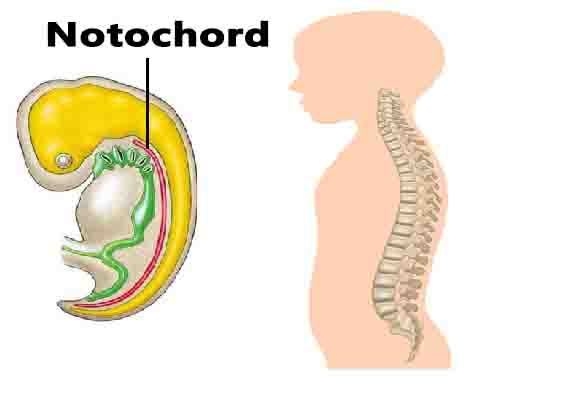Notochord Definition
A notochord provides rigid support to Chordate organisms by acting as an elastic rod. Among the more derived Chordates, the Vertebrates, the notochord is replaced by the vertebral column and becomes cartilaginous between vertebrae. Below is an image of a lancelet showing the notochord. Chordates with Lancelets are among the simplest.
Muscles attach to the notochord, which extends the length of the organism. Lancelets are able to swim in short bursts because of this. All Chordate organisms develop a notochord at some point, although they may lose it later on.
Tunicates, for example, attach to the bottom of the ocean and filter feed. The larval tunicate uses the notochord to swim to potential settling sites, while the adult tunicate does not need it. There are species that retain the notochord throughout their lives, and do not develop vertebral columns.
Invertebrate chordates are these animals. This group includes lancelets, tunicates, and even some large fish like sturgeons and coelacanths. Large fish have thick notochords that can be as long as they are (around 3-4 feet) and as thick as half an inch. This huge notochord is used by these fish in the same way vertebrates use their spines. Its only real difference is what it is made of and how it protects the spinal cord.
Vertebrates have bony vertebrae surrounding their spinal cords, protecting them from all sides. The spinal cord sits between the notochord and the skin, so animals with only a notochord lack this protection. In order to protect their spinal cord and notochord from damage, animals like the sturgeon and coelacanth have developed armored plates and thick skin.
The notochord is converted by vertebrates into cushioning intervertebral discs that prevent vertebrae from colliding. The notochord in the spine has been completely replaced by the time a human reaches the age of 4 years.
Notochord Structure
The notochord is made of a number of different structural molecules including glycoproteins and resembles cartilage in many ways. When you cut across the notochord, and view the cross section under a microscope, it appears as a series on concentric rings.
These different sized rings that surround each other are layers of the notochord, and are made from various structural molecules to give the notochord both strength and elasticity.
The glycoproteins and other structural molecules extend from cells, which are spaced far apart in the notochord. Each of these cells has a large vacuole, which it can pressurize. When pressurized, the cells push against one another and the surrounding structural materials. This creates an extra rigid notochord, which is necessary for swimming quickly.
Notochord Function
The strength of the notochord makes it a very useful structure to attach muscles to. Muscles need places for attachment in order to flex properly. By attaching muscles down the length of the notochord, small invertebrates can use muscles all over their body to swim. Even in the larger fishes which rely on a notochord, it provides enough support for most of the muscles of their body to attach to.
The turgor pressure created by the cells of the notochord make it extra rigid. While this provided enough support for many organisms, the vertebrates took this body plan one step further with the spine. The spine increase the rigidity of the notochord by being made out of bone, and further protects the spinal cord by fully encompassing it.
It has also been found that the notochord serves important signaling functions during normal vertebrate embryogenesis. A notochord secretes proteins which stimulate the formation of organ systems. This process, called organogenesis, starts when the embryo is a hollow ball of cells called the gastrula.
This tiny ball has three layers, and a notochord is derived from the middle layer, or mesoderm. Once created, the notochord begins secreting a number of chemical signals which further the process of organogenesis.
Eventually bones form and begin to create the spine. The notochord gets sandwiched between these vertebrae, and provide protection from the bones rubbing or smashing together.

